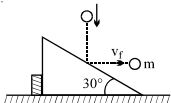As shown in the figure $a$ body of mass $m$ moving vertically with speed $3\, m/s$ hits a smooth fixed inclined plane and rebounds with a velocity $v_f$ in the horizontal direction. If $\angle$ of inclined is $30^o$, the velocity $v_f$ will be

As shown in the figure $a$ body of mass $m$ moving vertically with speed $3\, m/s$ hits a smooth fixed inclined plane and rebounds with a velocity $v_f$ in the horizontal direction. If $\angle$ of inclined is $30^o$, the velocity $v_f$ will be

- A
$3\, m/s$
- B
$\sqrt 3 m/s$
- C
$1/ \sqrt 3\, m/s$
- D
this is not possible
Similar Questions
A ball of mass $m$ strikes the inclined face of the wedge normally with speed $v_0$. The wedge is at rest on a rough horizontal surface before collision. The conservation of momentum is applicable for the event of collision for
$(i)$ $m$ as system, along $Y'$
$(ii) $ $M$ as system, along $Y'$
$(iii)$ $(M + m)$ as system, along $X$
$(iv)$ $(M + m)$ as system, along $Y$
Which of the following is correct?
A ball of mass $m$ strikes the inclined face of the wedge normally with speed $v_0$. The wedge is at rest on a rough horizontal surface before collision. The conservation of momentum is applicable for the event of collision for
$(i)$ $m$ as system, along $Y'$
$(ii) $ $M$ as system, along $Y'$
$(iii)$ $(M + m)$ as system, along $X$
$(iv)$ $(M + m)$ as system, along $Y$
Which of the following is correct?
A thin uniform bar lies on a frictionless horizontal surface and is free to move in any way on the surface. Its mass is $0.300\, kg$ and length is $2 \,m$ . Two particles each of mass $0.100\, kg$ are moving on the same surface and towards the two ends of the bar in the direction perpendicular to the bar such that one with velocity $10\, m/s$ towards one end and the other with velocity $5\, m/s$ towards the other end. If collision between particles and bar is completely elastic and both particles strike with the bar simultaneously. The velocity of centre of mass of the bar after the collision is ...... $m/s$
A thin uniform bar lies on a frictionless horizontal surface and is free to move in any way on the surface. Its mass is $0.300\, kg$ and length is $2 \,m$ . Two particles each of mass $0.100\, kg$ are moving on the same surface and towards the two ends of the bar in the direction perpendicular to the bar such that one with velocity $10\, m/s$ towards one end and the other with velocity $5\, m/s$ towards the other end. If collision between particles and bar is completely elastic and both particles strike with the bar simultaneously. The velocity of centre of mass of the bar after the collision is ...... $m/s$
A body of mass $2\,kg$ makes an elastic collision with a second body at rest and continues to move in the original direction but with one fourth of its original speed. What is the mass of the second body? ................ $ \mathrm{kg}$
A body of mass $2\,kg$ makes an elastic collision with a second body at rest and continues to move in the original direction but with one fourth of its original speed. What is the mass of the second body? ................ $ \mathrm{kg}$
- [JEE MAIN 2019]
Two identical spheres move in opposite directions with speeds $v_1$ and $v_2$ and pass behind an opaque screen, where they may either cross without touching (Event $1$) or make an elastic head-on collision (Event $2$)
Two identical spheres move in opposite directions with speeds $v_1$ and $v_2$ and pass behind an opaque screen, where they may either cross without touching (Event $1$) or make an elastic head-on collision (Event $2$)
A neutron makes a head-on elastic collision with a stationary deuteron. The fractional energy loss of the neutron in the collision is
A neutron makes a head-on elastic collision with a stationary deuteron. The fractional energy loss of the neutron in the collision is
- [AIIMS 2003]
